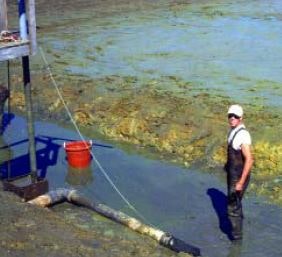5.2 Holding postlarvae before sale
You should not retain PL in your holding tanks for more than a week or two prior to stocking in nursery facilities, grow-out ponds, or sale. The length of time you hold them depends on the demand for PL. If you have to retain the PL longer, you must reduce the density of animals. You can then sell the prawns as juveniles, which have a higher value than PL, reflecting the increased costs of holding them longer.
Figure 40
The standpipe drain in this pond, normally vertical, is turned down to allow water to flow out (USA)

SOURCE: CHARLES WEIBEL
Whilst the PL are in the holding tanks you must continue to exchange the rearing water (40-50% every 2-3 days) and provide aeration. You can maintain PL at densities of up to 5 000 PL/m2 for one week (Note: once animals become PL, it is normal to refer to density on an area rather than a volume basis, that is per m2, not per m3), or up to 1 500-2 000 PL/m2 for one month under these conditions.
If you need to hold them for one month, you could improve survival if you reduce the density to 1 000/m2. Using substrates can help you maximize the stocking density, thus reducing other equipment and labour costs.
You do not need to continue feeding BSN after metamorphosis. You can immediately use the same diets as are used for pond feeding. However, some hatcheries prefer to use a floating diet in the holding tanks. This makes it easier to visually judge the quantity to feed. The young PL, although they tend more and more to cling to and crawl on surfaces, still swim quite actively in the water and utilize a floating diet well. A floating catfish diet or even an expanded pet food is adequate. Some hatcheries continue to use egg custard based diets for a few days.
Many grow-out farmers prefer to stock production ponds with juveniles instead of PL. If they do not want to have nursery ponds themselves, you will need to provide this facility on your own site. The management of nursery facilities is dealt with later in this section of the manual.